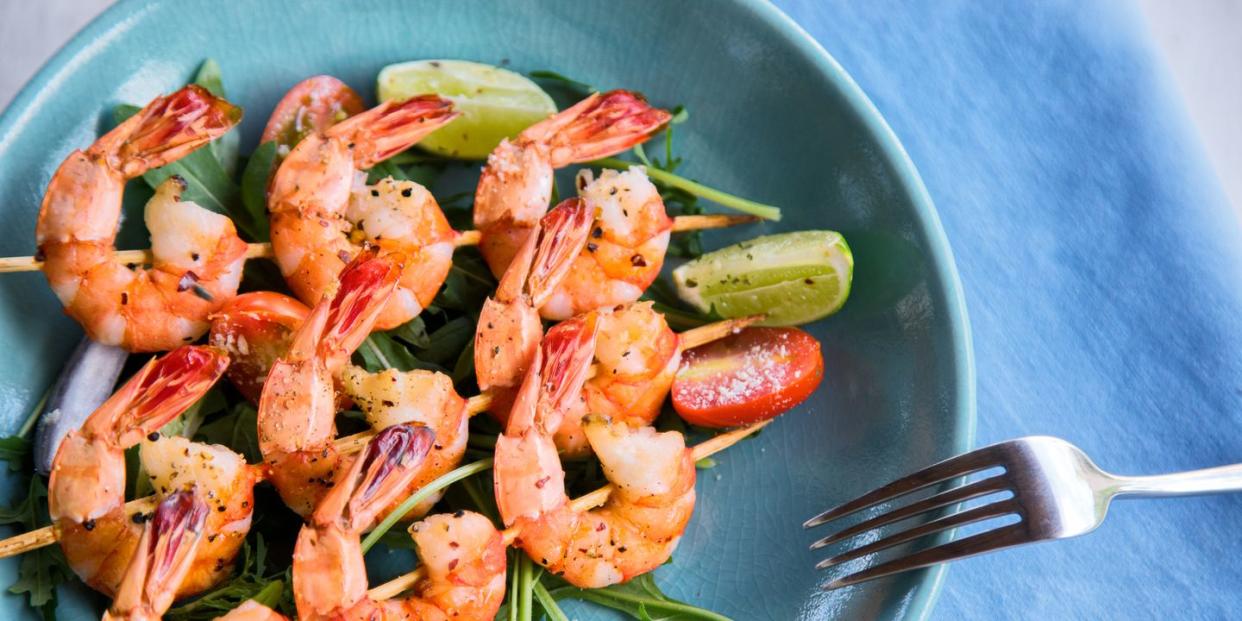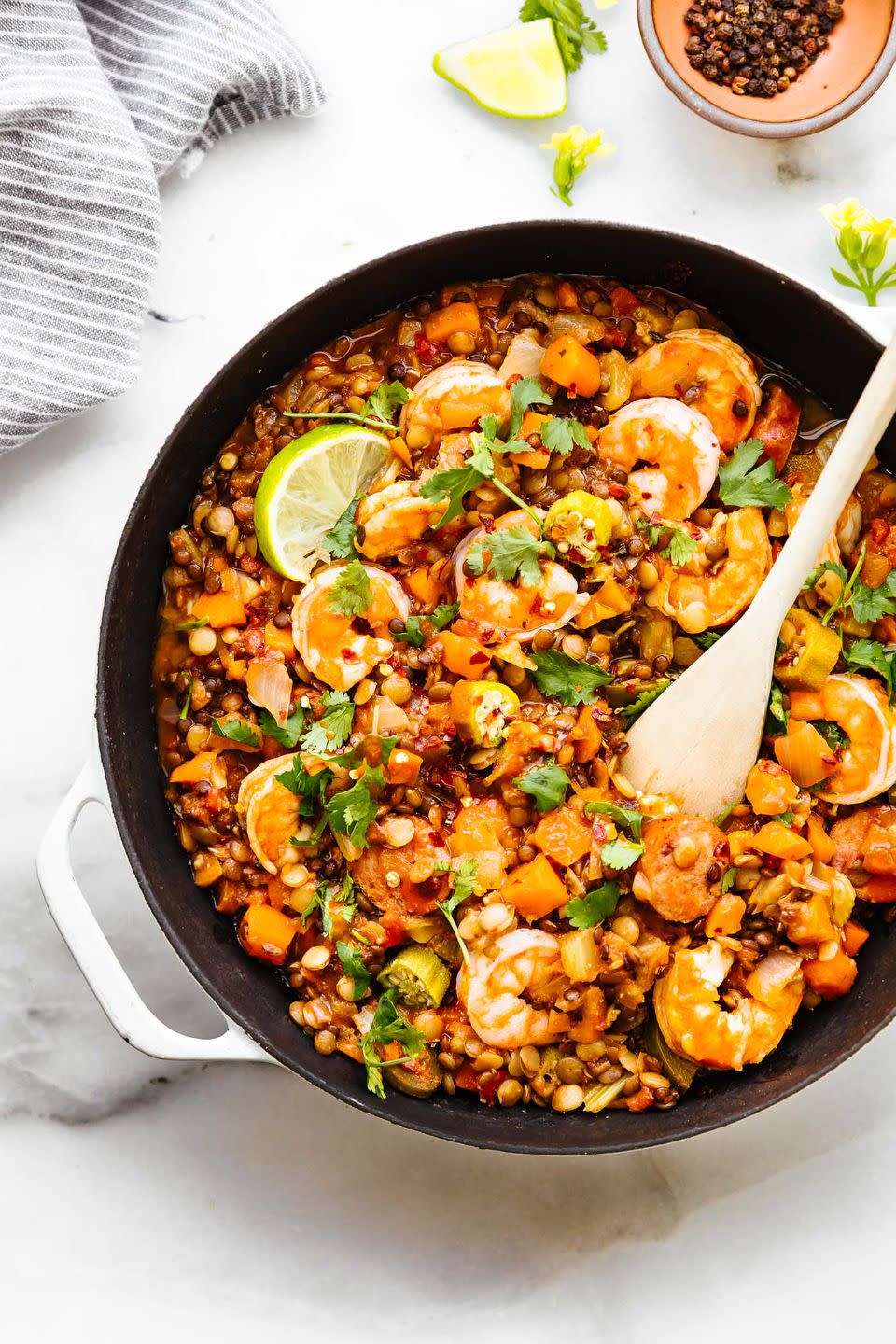Yes, You Need To Smell Shrimp Before You Buy It

If you've seen the movie Forest Gump, you know shrimp are insanely versatile. As one of the characters, Bubba, famously states: "You can barbecue it, boil it, broil it, bake it, sauté it..." (I'll spare you the rest of the list, but rest-assured, there are a lot of ways to prep this shellfish.)
But the real question: Is shrimp healthy? Sure, it's seafood, and I know fish is apparently good for you (see: the Mediterranean Diet winning best diet of 2019). But shrimp also gets a bad rap for containing tons of cholesterol.
So, should I actually be keeping up with my weekly shrimp taco night? Or...
Is shrimp healthy?
For starters, here's the nutrition breakdown of a four ounce serving of plain, cooked shrimp:
112 calories
27 g protein
0.32 g fat (0 g saturated fat)
0.23 g carbohydrates
0 g sugar
126 g sodium
Shrimp boasts a pretty impressive nutrient profile, with high doses of selenium, iron, iodine, phosphorus, niacin, zinc, and magnesium, says Robin Danowski, RD, assistant professor of nutrition at La Salle University. It has a small amount of omega-3 and omega-6 fats, which she says may promote brain and heart health. And most of shrimp's calories come from muscle-building protein, she says.
Finally, Amy Shapiro R.D. says shrimp contains a carotenoid antioxidant called astaxanthin, which reduces signs of aging and helps maintain eye sight.
To reap the health benefits, The American Heart Association recommends two servings of non-fried fish or seafood a week, and Danowski says shrimp can fill that quota. For portion sizes, she recommends three or four ounces, which usually comes out to around six to nine large shrimp.
Is there any reason I shouldn't eat shrimp?
Danowski says that those with a shellfish allergy should stay far away from shrimp. “It’s listed under the top eight allergens in the US, and the reaction can be as severe as those with peanut or tree nut allergies,” she says. She notes that tuna and salmon are both higher sources of omega-3’s, so they can be a great alternative if a fish allergy isn’t an issue.
Oh and if you're eating out, watch out for not-so-healthy shrimp options: tempura shrimp, popcorn shrimp, and garlic butter shrimp, according to Shapiro. “I would avoid any type of fried shrimp as it adds a lot of unhealthy fat to a lean protein and is often dipped in high-fat sauces,” she says.
Okay, but what about cholesterol?
Like most forms of animal protein, shrimp is high in cholesterol. But its bad rap is unwarranted. “It’s higher in cholesterol than most seafood, but dietary cholesterol has only a small effect on blood cholesterol,” says Danowski.
It's still true that a diet high in cholesterol can increase your risk of developing coronary heart disease, says Danowski. The American Heart Association recommends less than 300 mg of cholesterol a day, and shrimp contains 161 mg in a four ounce serving. However, that's minimal compared to the majority of processed foods and red meats in the standard American diet.
Plus, as Danowski points out, it's far more important to limit saturated fat intake than dietary cholesterol when it comes to heart health.
For some more healthy eating inspo, check out what Biggest Loser Chef Devin Alexander eats in a day:
How do I choose the right shrimp?
While food sold in commercial grocery stores in the US is fairly safe from contamination and antibiotics, according to Danowski, you want to be extra careful with shellfish, including shrimp. Here's her checklist for what to look for when you buy raw shrimp:
It's from a reputable supplier
It's firm to the touch
It has a mild odor that isn’t too fishy
It doesn’t make a difference whether you purchase your shrimp in a bulk bag from the frozen aisle or from the fish counter, as long as the shrimp meets the above criteria.
For an extra layer of security, you can always ask the employee serving the shrimp behind the counter if it came in frozen, when it was delivered to the store, and where it came from (the longer the distance, the higher the risk of spoiling in transit).
How can I make shrimp healthier?
The beauty of shrimp is that its mild taste and soft yet firm texture allow you to incorporate it into a variety of dishes. But not all methods of cooking are created equal. Your best bet, according to Shapiro, is to steam it in water or broth with your favorite spices. Otherwise, you can sauté, bake, or broil it in olive oil.
When ordering at a restaurant, Shapiro suggests a shrimp cocktail as an appetizer, which is simply boiled or poached without any extra ingredients. Or, “ask for it grilled and add it to salads or pastas as a low-calorie protein boost.”
Since sauces can be sly sugar and sodium bombs, Danowski says if you’re cooking at home, you can easily make your own cocktail sauce by combining your own preferred ratio of horseradish, ketchup, lemon juice and Worcestershire sauce, which she says can have fewer preservatives and calories than store-bought creamy dips.
For a few more healthy shrimp options, try these recipes at home:

Mango Shrimp Ceviche Recipe With Pineapple
Ceviche is Mexican cuisine’s best-kept secret to healthy, summery, and light-tasting shrimp. This recipe from Food Faith Fitness isn’t just Paleo and gluten-free-it offers a full serving of fruit, too.
Per serving: 145 calories, 4.5 g fat (1 g saturated), 10 g carbs, 5 g sugar, 407 mg sodium, 2.5 g fiber, 16 g protein

Cilantro Pistachio Pesto Shrimp Pasta
Pesto, pasta, AND shrimp? Yes, please! This meal is perfect for a sweet date night in...or if you're just craving some pasta. Bonus: It features brown rice spaghetti for a healthier alternative to white flour noodles.
Per serving: 448 calories, 18.4 g fat (3.2 g saturated), 54.6 g carbs, 1.3 g sugar, 407 mg sodium, 3.9 g fiber, 17.4 g protein
One Pot Shrimp Jambalaya Lentil Bowls

This healthier take on classic Cajun jambalaya features lentils instead of rice. Whip it up in a single pot for a flavorful and protein-packed weeknight dinner.
Per serving: 343 calories, 7.5 g fat (1.4 g saturated), 34.3 g carbs, 5.1 g sugar, 452.8 mg sodium, 7 g fiber, 36.6 g protein
('You Might Also Like',)

